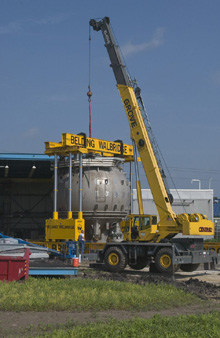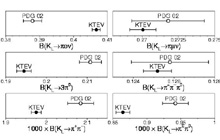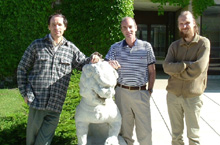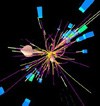 | Thursday, June 10, 2004 |
|
Thursday, June 10 THERE WILL BE NO THEORETICAL PHYSICS SEMINAR THIS WEEK 3:30 p.m. DIRECTOR'S COFFEE BREAK - 2nd Flr X-Over THERE WILL BE NO ACCELERATOR PHYSICS AND TECHNOLOGY SEMINAR TODAY
Friday, June 11 |
|
Thursday, June 10 Tomato Florentine Grilled Chicken Cordon Bleu Sandwich $4.75 Peachy Pork Roast $3.75 Chicken Marsala $3.75 Maryland Crab Salad $4.75 Italian Sausage Calzones $3.75 SW Chicken Salda with Roasted Corn Salsa $4.75 Wilson Hall Cafe Menu Chez Leon |
|
Extended Forecast |
Secon Level 3 |
| Fermilab Today is online at: http://www.fnal.gov/today/ Send comments and suggestions to today@fnal.gov Fermilab Today archive Fermilab Today PDF Version Fermilab Today classifieds Subscribe/Unsubscribe to |
Day of Mourning For Reagan Declared
|
|
Fermilab's 15-Foot Bubble Chamber Relocated | ||
| ||
|
A 281-ton bubble chamber, Fermilab's oldest particle detector, has become the lab's most valuable lawn ornament.
From 7:00 a.m. to noon on Tuesday, FESS and contractor Belding Walbridge used a hydraulic lift to move the
enormous metal sphere from its holding space in Lab A and placed it outside
on a concrete pedestal in the SiDet courtyard,
where it will remain on display.
"It cost $200 million to build Fermilab, and the bubble chamber was $25
million on top of that," said John Cooper of the Particle Physics Division.
"Bubble chambers were the premier detectors -- the CDFs or DZeros of the 1960s."
Installed in 1973, the 15-foot bubble chamber allowed Fermilab physicists to track elusive high-energy particles like kaons, lambdas, and electrons, and provided detailed views of decay vertices. Particles penetrating the superheated hydrogen inside the chamber left bubble tracks, which could be photographed and reconstructed in 3D. Though the chamber was unable to process multiple, or even successive particle collisions, its high quality imaging has been surpassed only recently by the newest generation of particle detectors. It was used in 17 experiments over a period of 15 years. "Bubble chambers played an instrumental role in several early discoveries," said Dixon Bogart, associate head of the Accelerator Division. "It was one of the first major pieces of experimental equipment built at the lab."
The move prompted nostalgia. "I saw the chamber first lowered into the ground
when I was a little kid," said Pete Simon, building manager at DZero.
His father, George Simon, who was also present yesterday, had operated
the device from 1973 to 1987. "It was hard work, but always interesting,"
George Simon said. "But you had to keep an eye on it constantly."
|
|
From Nature Magazine, June 9, 2004 Particle physics: From the top... by Georg Weiglein The basic building-blocks of matter, as far as we know, are quarks and leptons, together with the force-carrying particles that mediate their interactions. Quarks and leptons (the latter group including the electron) are grouped in three generations; the particles in the second and third generations seem a perfect copy of those of the first generation, except that their masses are much larger. The top quark is the heaviest of all quarks and leptons, and is central to some of the most pressing questions in particle physics. For instance, why is the third-generation top quark more than 300,000 times heavier than the first-generation electron? Why are there two other quarks with precisely the same properties as the top quark but with very different masses? And what is the origin of mass itself? read more |
|
A New Determination of Vus by KTeV | ||
| ||
|
Although the neutral kaon was discovered more than 50 years ago, it
continues to be a unique tool for particle physics. The KTeV
collaboration has recently completed a series of measurements of
neutral kaon decay, resulting in a new determination of the CKM matrix
element Vus.
The CKM matrix describes the coupling of the u, c, and t quarks to the d, s, and b quarks. Much recent attention has been given to the possible deviation from unitarity in the first row of this matrix. There has been particular interest in checking the Vus element (describing the coupling of s quarks to u quarks), because it was based on averages of dozens of experiments done over a 40 year period. To determineVus, KTeV has measured the six largest KL branching fractions (accounting for more than 99.9% of all K-long decays) and the form factors in semileptonic kaon decays. This work marks the first time these measurements have all been performed together in a modern, high statistics experiment. The KTeV branching fraction measurements are about a factor of two more precise than the averages of all previous measurements, but are not in good agreement with the averages. In particular, the important KL to pi e nu branching fraction is about 5% higher than the previous world average. This shift is consistent with the higher semileptonic branching fraction recently measured in K+ decay by Brookhaven experiment E865. The new KTeV results are consistent with unitarity of the first row of the CKM matrix. Articles reporting these results were submitted to Physical Review Letters and Physical Review D on June 1. | ||
| ||
|
Result of the Week Archive
|
Fermilab Results Change Higgs Mass Estimate
read more |
|
June 7 - June 9 - Operations established one store during this 48 hour period that combined with an existing store provided approximately 42 hours and 21 minutes of luminosity to the experiments. - TeV sets NEW initial luminosity record of 76.8446E30 - TeV registers mysterious beam spike on Tuesday morning - Off site power glitch causes many devices to trip off. Store remained intact. - TeV, MI, Pbar, and Recycler prepare for Mixed Mode antiproton transfers.
View the current accelerator update |
|
New Books in the Fermilab Library New books in the Fermilab Library for the week of June 8 are now on display in the Library near the front desk. An online list of the new books is now available. New books may be reserved by using the online Library catalog or by calling the library at x3401, or by filling out the reserve card in the book.
Fermilab June Golf Outing |




